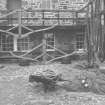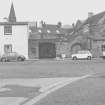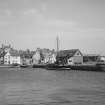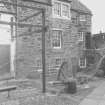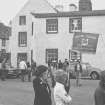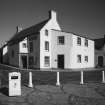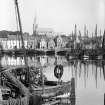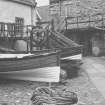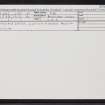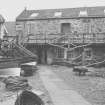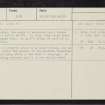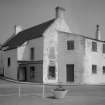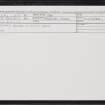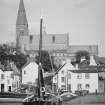Following the launch of trove.scot in February 2025 we are now planning the retiral of some of our webservices. Canmore will be switched off on 24th June 2025. Information about the closure can be found on the HES website: Retiral of HES web services | Historic Environment Scotland
Anstruther Easter , Harbour Head, Scottish Fisheries Museum
Chapel (15th Century), House (16th Century), Museum (20th Century)
Site Name Anstruther Easter , Harbour Head, Scottish Fisheries Museum
Classification Chapel (15th Century), House (16th Century), Museum (20th Century)
Alternative Name(s) St Ayle's House; Abbots Lodge; Harbourhead; Anstruther Harbour
Canmore ID 34073
Site Number NO50SE 21
NGR NO 56879 03483
Datum OSGB36 - NGR
Permalink http://canmore.org.uk/site/34073
- Council Fife
- Parish Anstruther Easter
- Former Region Fife
- Former District North East Fife
- Former County Fife
NO50SE 21.00 56879 03483
Museum [NAT]
OS (GIS) MasterMap, July 2010.
NO50SE 21.01 56855 03487 50 East Shore, Ship's Chandlers Shop
See also NO50SE 61.
For (contiguous) Sun Tavern and Harbour Head House, see NO50SE 40.
At Anstruther, the monks of Balmerino had a chapel named St Ayle's (NO50SE 13). In 1535, they feued their property to Thomas Wood. St Ayle's House, or part of it, is still standing.
A H Millar 1895
There is no property known as St Ayle's House, but at NO 5687 0347, within the grounds of the Scottish Fisheries Museum, is a building known as the Abbot's Lodgings. It is currently being restored and it is not easily dated.
Visited by OS (JP) 29 May 1974.
Scottish Fisheries Museum, Harbourhead, Anstruther Easter. A complicated two-storey group forming a quadrangle, restored and converted to its present use by W Murray Jack in 1968-70. Entrance in the S range, which is late 19th century, incorporating an earlier wall. N range dated 1721 but with a pair of lancets from the medieval St Ayles chapel (NO50SE 13) which stood on the site. The brick E range was built as a cooperage, c. 1850. At its end, a late 16th century house with a projecting stairtower and, inside, a large moulded fireplace. The W range (NO50SE 21.01), a former ship's chandler's shop and house, has a moulded doorpiece of c. 1700.
J Gifford 1992.
The museum has been extended to incorporate the workshop and store of the (former) boatbuilding yard of Messrs. Smith and Hutton, for which see NO50SE 61.
Visited by RCAHMS (RJCM), 11 March 1998.
[Scottish Fisheries Museum 1998].
A courtyard of buildings on East Shore, Anstruther Easter was converted into a museum in 1970.
Photographic Survey (July 1963)
Photographic survey of buildings in Anstruther Easter, Fife, by the Ministry of Work/Scottish National Buildings Record in July 1963.
Publication Account (1987)
The Scottish Fisheries Museum was opened in July 1969 in a group of old buildings known as 'St Ayles'. Its situation on this site is most appropriate as, in addition to overlooking the harbour, St Ayles Land has recorded connections with fIshing and fIsherfolk dating from 1318. In a charter of that date William de Candela, Laird of'Anstroyir', gave the land and certain rights to the Abbey of Balmerino. The rights included the erection of booths for lease to local fishermen and permission to dry nets on the land. A community of fishermen, coopers and brewers settled on the land and St Ayles Chapel was built in the 15th century on the site of the north building of the museum. A double-sided window-head rebuilt into the present structure is the only visible evidence to survive.
The Abbot's lodging on the east side of the courtyard is reputedly the oldest building on St Ayles Land, dating from the 16th century. If this date is correct the building has obviously undergone a major remodelling at some subsequent date. Much more convincing is the 18th century dwelling built by the brewer William Lumsden on the other side of the courtyard. Originally 3 storeys, it was reduced in height and used as a ships' chandlers until 1961. The marriage-lintel reading 'WL HD 1721' can still be seen over the doorway in Haddfoot Wynd. The whole group has an air of having been lived-in and altered over the years to suit changing requirements. The museum has recently purchased some further houses to the north-east, one of which has a good example of an Eyemouth kiln, which has been converted for use as a domestic laundry. This will eventually make a fine exhibit when the linking galleries are commissioned.
The museum buildings contain a number of galleries devoted to various themes. These include: boats, boatbuilding, coopering, fIshing gear, fisheries protection, marine engineering, navigation, North Atlantic fishing grounds, sail making and whaling. There are also examples of fisher dress, paintings, ships' fIgureheads and tapestries. A salt-water aquarium and floor pool give an excellent view of a variety of fish and shellfish found in Scottish waters. Re-creations of a net loft and a fIsher family room of around AD 1900 show items in context. This approach is also taken in a number of other situations including a walk-through wheelhouse complete with ship's radio and radar in working condition. A small room is given over to a memorial to fishermen lost at sea.
The courtyard contains a fine collection of small boats but this is only part of the boat collection, the larger items being berthed in Anstruther and Tayport harbours. The large boats include: Reaper FR958, a 22m Fife herring drifter built by Forbes of Sandhaven in 1902; Research LK62, a 24m Zulu herring drifter built by Slater's of Banff in 1901; Radiation A115, the largest wooden line-fIshing vessel built in Britain, 29.5 m long, built by Smith and Hutton of Anstruther in 1957 (in Tayport harbour); and Light A395, smaller than the others at only 5.5m long, a Moray Firth sma'line boat built at Rosehearty in 1906.
Information from ‘Exploring Scotland’s Heritage: Fife and Tayside’, (1987).
Laser Scanning (25 May 2010 - 26 May 2010)
Headland Archaeology undertook a laser scan survey of the Zulu Class sailing drifter 'Research', currently located in the permanent collection at the Scottish Fisheries Museum in Fife. The survey was instigated on the request of the museum through concerns regarding the de-stabilisation of the vessel hull fabric. As such, the laser scan was proposed to create a full record of the vessel and establish a control for the continued monitoring of the hull condition. It is hoped that the laser scan survey will help inform the development of a conservation and management strategy for the vessel. A Method Statement was prepared to accommodate a full survey of the vessel which succeeded in providing a full and accurate 3D archaeological record in addition to the provision of useful 'engineering' data to help in the development of a conservation management strategy. The digital archive for the project presently resides with the Edinburgh office of Wessex Archaeology, who will take responsibility for archiving.
Information from OASIS ID: headland1-244312 (J van Wessel) 2010.
Standing Building Recording (20 June 2013 - 29 April 2014)
NO 56879 03483 An historic building survey was undertaken of the whale store, which forms part of the Scottish Fisheries Museum. A photogrammetric survey was also made of a carved stone bearing the image of a ship. The ship is thought to be a mid-18th century whaler of the type serviced by the whale store at Anstruther Easter during the 1750s, by the Anstruther Whale Fishing Company for the early Arctic Whale Fishery.
This work was undertaken 20 June 2013 – 29 April 2014.
Archive: RCAHMS (intended)
Funder: Scottish Fisheries Museum
Andrew Bicket - WA Heritage
(Source: DES)
























